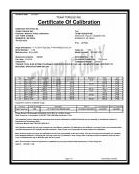| NDT Equipment Calibration Equipment calibrations are required in accordance with AS9100/AC7004 quality system requirements on production equipment, tools and programs or any other such device that is needed to provide evidence of conformity of a product or service to specified requirements. These specified requirements are usually flowed down by customer specifications or standards that are required to be met in the production of a product or service. Equipment must be calibrated or validated prior to use, maintained and inspected periodically according to documented procedures. Whether your equipment is calibrated / validated by an outside source or internally, a register of these monitoring and measuring devices shall be maintained and define the process employed for their calibration including details of equipment type, unique identification, location, frequency of checks, check method, range to be checked, number of points over the range to be checked (3 minimum, unless otherwise stated) and acceptance criteria / accuracy required. These calibration details and any governing specification(s) must also be flowed down to any external calibration source either by including the information directly on a P.O. with the calibration system requirements (e.g. ANSI/NCSL Z540 or ISO 10012) or by referencing a document on the P.O. with these requirements that goes with the P.O. to the calibration source. Storage requirements, including periodic preservation/condition checks, shall be established for production equipment or tooling in storage. The organization shall establish processes to ensure that monitoring and measurement can be carried out and are carried out in a manner that is consistent with the monitoring and measurement requirements. The organization shall ensure that environmental conditions are suitable for the calibrations, inspections, measurements and tests being carried out.Where necessary to ensure valid results, measuring equipment shall
NOTE: See ISO 10012-1 and ISO 10012-2 for guidance. Calibration Reports
Calibration reports shall be reviewed upon receipt by an individual who can determine the adequacy of the report and the review must be documented in some way. Usually there is a name, signature or stamp and date placed on the certificate indicating review. Whoever, you have reviewing these; make sure they do a good thorough review. I often find out-of-tolerance reported and find out no other review was done to determine possible product impact. If you have to do an investigation for an OOT condition, make sure you document the investigation and at least attach a copy of the investigation and results to the calibration report. Extension of Calibrations If you intend to extend the frequency of a calibration, be sure your governing specifications allow it. The calibration procedure must address the criteria to either extend or reduce the calibration frequency for the specific equipment. The Nadcap baseline handbook has established, when permitted, that a decrease in a calibration frequency can be done only when four (4) consecutive acceptable calibrations and adequate documentation is available to support the extension. Measuring Devices and Calibrations There are some pieces of equipment that may not require a full blown calibration after initial calibration. Items such as reticules for eye loupes, measuring templates, steel rules or scales are non-variable. For item like this, you do need an initial calibration and certification, then subsequently and verification of the condition of the item is performed. This is normally done on an annual basis. What is looked for is wearing away of the incremental markings, or other damage that would render the item unusable. Of course, the technician should be watching out for this each time he or she uses the item, but an annual verification is documented. It is IMPORTANT to remember, you must keep the original calibration certificate on file and available for audit review by your customer or their representatives. |
|||||||

